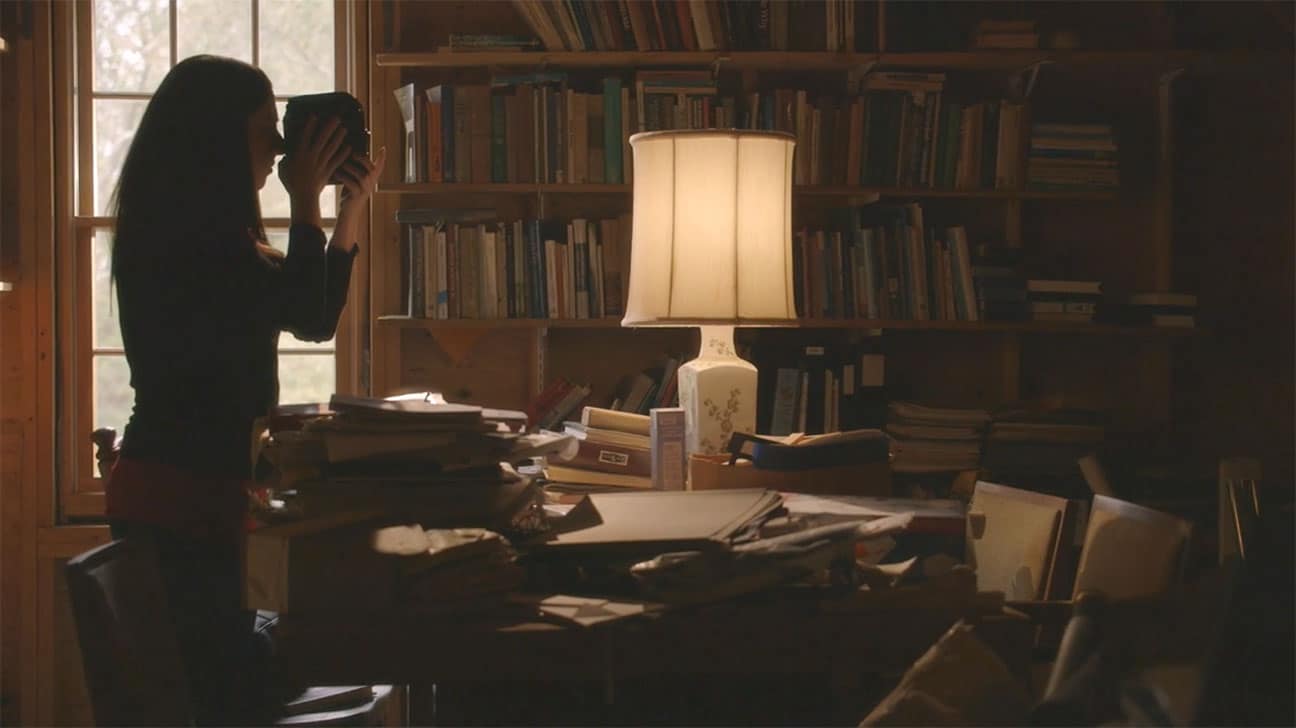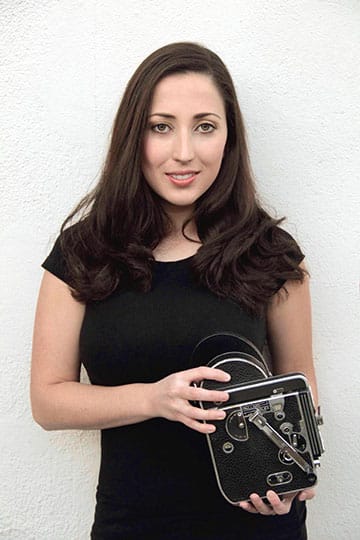 Alyssa Bolsey in the attic with her Bolex
Alyssa Bolsey in the attic with her Bolex There is an origin story for every filmmaker. And many of the directors that we laud the most today had their first taste of filmmaking with the Bolex camera in their hands.
First built in the 1920s, it was a precursor to the smartphones that four out of five humans use today (but without the planned obsolescence). Compared to other film-recording devices of its time, it was small, portable and built like a tank. It was welded with the finest of metals and gears with Rolex-level precision and quality. It was self-powered and so capable that the Bolex was the go-to entry-level film camera for icons Andy Warhol, Maya Deren, Steven Spielberg, Peter Jackson and Spike Lee.
But that’s only part of a fascinating story presented in a new documentary, “Beyond the Bolex,” where director Alyssa Bolsey documents the story of her long-lost family legacy with one of the most influential inventions of the 20th century—one of the first 16mm fully-automatic motion picture cameras.

It all started while Alyssa was digging through the belongings of her recently deceased grandfather Emil. As a film student at the time, Alyssa took a particular interest in the plethora of old cameras and film stored by her grandfather. But one camera in particular was “wrapped like a present”—a Bolex camera. Upon further inspection and digging, Alyssa learned that her great-grandfather, Jacques Bolsey, was the inventor.
“I actually wasn’t setting out to make a documentary when I went to film school, I was going to do fiction films and this kind of fell into my lap—quite literally—in the form of boxes of family reels,” Alyssa told the Journal.
A throughline of the documentary is Alyssa trying to find out why the details of the life her great-grandfather Jacques had been obscured for so long.
Jacques passed away in 1962. So as the only filmmaker in the family, Alyssa set out to interview early film experts, preservationists, and other descendants of her great-grandfather.
“Through making it, I started feeling like I had a relationship with my great-grandfather who I never met,” Alyssa said.
Born Yakov Bogopolsky in 1895 in Kyiv (as part of the Russian Empire), Jacques launched a photography business in his neighborhood around 1910. He had dreams of studying medicine, but there were quotas in Russia restricting the number of Jews pursuing that profession. So he left his family behind at age 17 to study medicine in Switzerland, where he would also support himself by drawing portraits of his professors.
It was there that a professor lamented that he wished to have a camera to film the open-heart surgery of a dog. Jacques volunteered to build that very device.
The early Bolex cameras were so well-received that Jacques’ company was bought by The Paillard Company in the mountains of St. Croix, Switzerland in 1930. They kept Jacques on board as a consulting engineer for the next five years. During that time, The Paillard Company sent him nasty letters expressing distrust. Rising anti-semitism in Europe may have played a role.
As World War II was breaking out, Jacques’ residency was denied by Swiss authorities, and his sons were drafted into the Swiss military. So in 1939, Jacques moved to the United States alone, leaving behind his wife Mariette. She was supposed to join Jacques in the U.S. a few months later, but stayed behind as World War II erupted. Jacques would remain separated from his family for the entirety of the war.
From there, “Beyond the Bolex” dives deep into an inspiring story of the hurdles and heroics of being a Jewish inventor and immigrant to the U.S. in the first half of the 20th century.
“Beyond the Bolex” is a comforting display of how film can forge a bridge between generations of family who have never met. The film will have viewers reflecting on how much we take for granted the smartphone filming capabilities that have become so ubiquitous for people today.
“[The Bolex] wasn’t a tool for people, it was more like a friend,” Alyssa said. “If you think about it, what have you had your entire life to capture your fifth birthday, but then also your 21st birthday? A lot of people have had a Bolex to capture 40-50 years of their lives. Maybe they pass it on, maybe they sell it at a garage sale? And so every camera has a story.”
Alyssa’s touch for stringing together her long-lost family history is a prime example for directors on how to make a deeply personal documentary without making it about yourself. The documentary is a must-see for young filmmakers looking for a passion project to emulate.

“And now even in film schools, a lot of them don’t use 16mm film anymore, but some do,” Alyssa said. “And I think a lot of the younger generation coming up right now, they’ve grown up in a completely digital world. They never touched VHSs or tapes or records.I think they’re kind of getting really frustrated with not having anything tangible, so there’s a moment happening right now where we’ll see what happens. There’s something about film where you have to have a whole new patience that we don’t really use these days, but at the same time, there’s a magic to it.”
That said, Alyssa discovered that even her great-grandpa Jacques had a collection of what we would refer to today as “selfies” and Bolex-filmed cat videos that would be ripe for Tik-Tok.
Without giving away too much about one of the most powerful scenes, young filmmakers watching “Beyond the Bolex” get some simple advice about filmmaking from great-grandpa Jacques: “It’s not about place, it’s about context.”
Fans of Steven Spielberg’s new semi-autobiographical drama “The Fabelmans” will find that “Beyond the Bolex” is excellent complimentary content. Corey Wallace’s score cements the well-paved paths from the film’s ragtime-era footage with the modern day emotional scenes.
Dave Alex Riddett, cinematographer on “Wallace and Gromit” and other Aardman Animation films, called the Bolex “a box of tricks.” Peter Jackson, director of “The Lord of the Rings” trilogy said that “they are nice and light and you can do a lot of camera moves with them.” Bruce Brown, director of “The Endless Summer” likened the Bolex camera to heaven.
“Beyond the Bolex” will inspire some viewers to take a moment on their own Bolex cameras (masquerading as smartphones) to distill their thousands of videos into a family story that moves them. Or at the very least, the film will inspire all viewers to ask questions about the great-grandparents that they may have never met.
A virtual screening of “Beyond the Bolex” takes place now through December 4th, 2022 11:59 PST. Tickets are currently available at https://bit.ly/3UZBdfv. For more information on the documentary, visit www.beyondthebolex.com.























 More news and opinions than at a Shabbat dinner, right in your inbox.
More news and opinions than at a Shabbat dinner, right in your inbox.